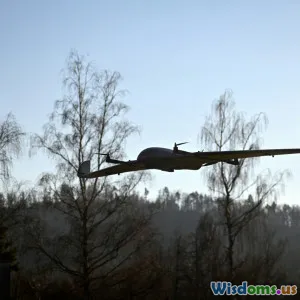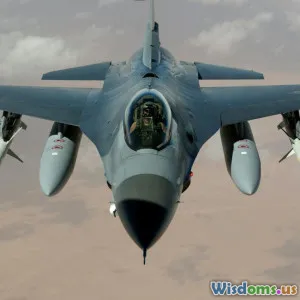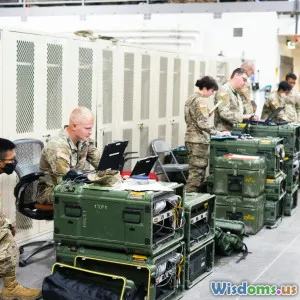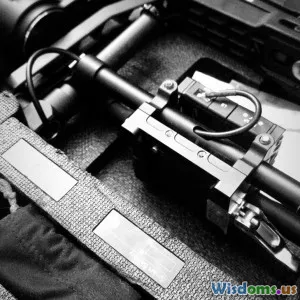
Battle Tested Lessons From Ukraine’s Air Defense Operators
14 min read Discover how Ukraine’s air defense operators adapted, innovated, and set new benchmarks in modern warfare, offering practical battlefield lessons for current global defense strategies. (0 Reviews)
Battle Tested Lessons From Ukraine’s Air Defense Operators
Introduction: Under Fire, Building the Future of Air Defense
In the chilling hours of February 24, 2022, the night sky over Ukraine erupted with sirens and streaking missile trails. As the world watched in suspense, Ukraine’s air defense operators—some seasoned, many newly trained—became the last line between Russian aerial strikes and countless civilian lives. Facing overwhelming odds, outdated hardware, and a barrage unlike anything seen in Europe since WWII, these operators did more than just survive; they redefined how nations think about defending their skies.
How did Ukraine—assailed by one of the world’s most formidable militaries—keep fighting, innovating, and even thriving in the skies above? The answers, born of determination, improvisation, and relentless courage, hold indispensable lessons not just for militaries but for any nation or organization facing rapid technological and tactical change. This is more than a story of missiles and radars—it's about agility, cooperation, creativity under fire, and the relentless human drive to protect and prevail.
Facing the Barrage: The Initial Challenges
When Russia unleashed its first waves of cruise missiles, ballistic rockets, and UAVs, Ukraine’s air defense arsenal appeared woefully outmatched. The country's core consisted of aging Soviet-era systems—S-300s, Buk-M1s, and Osa-AKs—designed for older, different wars.
In the early months, Ukrainian cities endured more than 800 long-range missile and drone attacks—strains that even Western European capitals might have struggled to withstand. Kyiv, Kharkiv, Dnipro, and Lviv endured relentless nighttime bombardment. Yet, by late 2022 and 2023, the effectiveness of these strikes diminished sharply: Ukrainian operators were learning, adapting, and reshaping the battle in real time.
Key Realization: Outdated Equipment Isn’t a Death Sentence
Major Sergiy, an air defense field commander near Mykolaiv, described in an interview:
“At first, we were hunting MiG-31s and cruise missiles with radars older than most operators’ parents. But we found the gaps in old manuals, listened for the ‘signature sounds’ with our ears, even when radars failed—and we hit back. Hard.”
Evolution Through Necessity: Adapting to Advanced Threats
The sheer variety and technological sophistication of Russian aerial threats were staggering: cruise missiles like the Kalibr and Kh-101, Iskander ballistic missiles, and massive swarms of Shahed-136 “kamikaze” drones. Ukraine’s playbook had to change overnight.
Integrating Old and New Systems: A Tapestry Defense
Ukraine became a living laboratory for what military planners call layered air defense. Aging Soviet S-300s and Buks guarded mid-to-high altitudes, while rapidly arriving Western systems—IRIS-T, NASAMS, Patriot (U.S.), Gepard (Germany)—stepped in to cover blind spots or intercept at different ranges.
Example: The IRIS-T and Patriot Edge
- IRIS-T: This advanced German system achieved a 100% intercept rate for several weeks at the height of 2022’s winter attacks in Kyiv.
- Patriot: On May 4, 2023, Ukrainian operators with just weeks of hands-on training managed to intercept a barrage of six Kh-47 Kinzhal hypersonic missiles—a feat previously believed impossible by many in the West.
Lesson: Integration and flexibility trump purity or standardization. Hybrid arsenals—when creatively led—can adapt faster and outperform more homogenous but less nimble forces.
DIY and Innovation on the Fly
With supplies limited, Ukrainians mastered “cannibalization”: dismantling irreparable launchers for spare parts, coaxing radars into service beyond their shelf-lives, and rigging new communications links using civilian tech (off-the-shelf radios, mesh networks similar to those used by Uber drivers or gamers).
Real-World Innovation
- Bush Telegram: Operators organized civilian spotters via encrypted Telegram channels to report drone or missile sightings. This transformed air raid alerts from hours’ notice to minutes or seconds, enabling rapid repositioning or concealment of valuable assets.
- Starlink Empowerment: The integration of Starlink internet access after key ground stations were knocked out supplied resilient, real-time battle data for coordination—even under fire.
“Our best computers weren’t in command centers—they were the collective brains of 40 million Ukrainians sending tips and sightings,” remarked an Air Force liaison interviewed by Reuters in November 2022.
The Age of the Drone: From Nemesis to Neutralizer
Few symbols encapsulated the modern air war like the Iranian-made Shahed drones. Often swarming at night and flying low to evade radar, their distinctive buzz became a sound of terror and, ultimately, innovation for Ukrainian defenders.
Countering Drones: Flexible, Networked, Relentless
Early Failures, Later Triumphs
Initial efforts to stop drone swarms with expensive missiles risked burning through finite supplies (one Shahed-136 costs $20,000; a launched S-300 missile over $1 million). Air defense units needed smarter, cheaper solutions—fast.
Layered Response
- Small Arms & Machine Guns: Forward observers with night vision or thermal scopes alerted rapid-response squads, which shot down drones with heavy machine guns and small arms.
- Mobile Anti-Aircraft Artillery: Gepards (German self-propelled anti-aircraft guns) shot down more than 50 drones in October 2022 alone around Odesa and Mykolaiv, according to Ukrainian Army statistics.
- Electronic Warfare: Portable EW units jammed GPS navigation in drone “kill boxes,” causing drones to crash harmlessly or miss targets.
“By early 2023, our drone kill rate was over 70%. Drones forced us to rethink everything—how we detect, shoot, and even recruit talent with the right instincts,” described Volodymyr, a Gepard crew leader.
Industrial Countermeasures: Manufacturing at Home
As air defense demand exceeded international supply lines, Ukraine rapidly expanded domestic production of drone-portable radars, signal jammers, and mobile anti-air systems. The country’s thriving tech sector turned hackathons into war effort sprints—prototyping, testing, and deploying units in mere weeks.
Creating a Twenty-First Century Sentinel: Tech and Training Transformation
Urgent Upskilling: Training Under Fire
Ukraine’s vast mobilization of air defense personnel meant hundreds of new operators needed to be trained—fast. Instead of traditional months-long courses, “crash” curricula focused on:
- Detection skills: Using sound, thermal signature, and visual cues.
- Cross-platform operation: Learning to switch between multiple old and new systems within days.
- Real-time adaptation: Simulated attacks and AI-guided software that mimicked ever-evolving Russian tactics in daily drills.
The Cross-Training Advantage
Ukrainian teams rotated between systems, jobs, and even regions to prevent skill silos. This cross-experience bred a uniquely adaptable workforce, able to operate everything from a 1987 Buk to a 2023 NASAMS control pad with minimal downtime.
Decision-Making Under Pressure: Decentralization & Agility
Unlike traditional “top-down” command, Ukrainian air defense increasingly empowered battlefield commanders to make high-stakes decisions on the spot. Distributed leadership reduced response times and led to stunning tactical victories:
- On October 10, 2022—the so-called “terrible Tuesday” that saw over 84 missiles fired across Ukraine—localized defense cells, using shared intelligence and quick field discretion, knocked out 43 of them, foiling one of the largest aerial barrages of the war.
Information Warfare and Psychological Resilience
The Role of Transparency
Unlike the secretive Soviet doctrine, Ukraine’s Air Force actively informed civilians about risk, ongoing operations, and successful repulsion of attacks. Social media disseminated real-time information, praise for operators, and safety protocols.
Results?
- Civilian Fatigue Reduced: Regular, public communication helped demystify air defense effectiveness, boosting public morale and minimizing panic.
- Operator Pride: Positive coverage and recognition increased recruitment and retention, as “air defender” became a celebrated title.
Coping with Unrelenting Pressure
Air defense operators worked ceaselessly for months, sometimes in underground bunkers, isolated, and vulnerable to retaliation. To combat burnout, leadership instituted rotating shifts, mental health breaks (a rarity in most militaries), and offered wellness support through NGOs.
External Partnerships: Tapping Global Expertise
International Training and Rapid System Delivery
Ukraine’s partnership with Western powers led to feats—including the rapid delivery and practical instruction on highly classified NATO systems—that analysts previously thought improbable.
- Ramstein Air Base: Ukrainian teams were trained by German, Norwegian, and U.S. mentors in simulated and live-fire exercises, achieving basic operational safety in under four weeks (compared to the U.S. military’s usual one-year pipeline).
Real Collaboration
Air defense data and lessons flowed both ways: Ukraine reported back on system weaknesses, leading to near-instant improvements in Western hardware still under development (e.g., radar tuning, adaptability for swarm attacks).
Supply Chain Innovation
Operators learned to service and upgrade high-tech Western systems without benefit of manufacturer-exclusive technicians—repurposing local engineers and even university students for basic repairs and diagnostics.
Lessons That Reach Far Beyond Ukraine
From the battered landscapes of Kyiv to the workshops humming in Lviv, Ukraine’s air defense operators rewrote what resilience—and victory—looks like in the 21st century.
What Global Militaries Should Remember:
- Layered, Multi-Origin Defense Is a Feature: Diverse systems, creatively networked, outperform monolithic arsenals.
- Civilian-Military Synergy Accelerates Change: Harnessing society-wide knowledge, intelligence, and innovation multiplies effectiveness beyond the typical defense budget.
- Speed and Decentralization Save Lives: Empowering frontline commanders, training for cross-system agility, and sharing real-time data are edge-defining priorities.
- Drone Threats Require a Whole-of-System Response: Adapting AA artillery, EW, machine guns, and quick logistics win the attrition game.
- Resilience Has a Psychological Dimension: Communication and pride empower defenders just as much as hardware.
“Every new threat became a test. Each time, we adapted faster than our enemy thought possible. That’s the lesson: Defense is a living, learning system,” summarizes Colonel Andriy, head of Ukraine’s air defense academy, in a 2024 interview for The Times.
Conclusion: A Blueprint for the Future of Air Defense
Ukraine’s air defense battle is far from over—but the world has already learned from these operators’ ingenuity, grit, and sacrifice. As long-range missile technology, drone warfare, and hybrid attacks spread globally, their field-tested innovations are now shaping defense policies from Warsaw to Washington to Tokyo.
The ultimate lesson? True air defense leadership is not about owning the world’s shiniest missiles—it lies in how quickly, cooperatively, and creatively societies can harness all their talents to adapt, improvise, and prevail. For every civilian alive above ground in Ukraine today, the proof is written in courage—and in sky-traced, hard-won innovation.
Sources:
- Interviews with Ukrainian Air Force personnel, 2022-2024.
- Ukrainian MOD and Army statistics.
- Reports from The Times, The Economist, Reuters, BBC, and open-source defense analyses.
- RAND Corporation, "Lessons Counter-Salvo", 2023.
- Oryxspioenkop, independent weapon system monitoring.
Rate the Post
User Reviews
Popular Posts




















